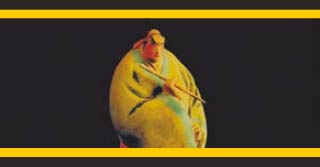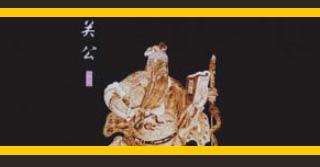|
header
|
 |
|
MENU
|
|
 |
WENZHOU RICE SCULPTURE
27/11 ~ 09/12
2007
Rice sculptures were popular
in Wenzhou City during the years of the Qing Dynasty.
They originally played a role on occasions such as
birthdays, marriages and dinners celebrating the first
month of a newborn baby but later emerged as a cherished
form of handicraft. Glutinous rice and rice are ground
into powder, coloured and steamed. The resulting product
is then fashioned into human figures, dragons,
phoenixes, flowers, birds and beasts by rubbing,
kneading, pinching and carving. The final figures are
vivid and lifelike.
Wang Jinrong
- one of the artists who perpetuates the tradition of
Wenzhou Rice Sculpture – has earned an enviable
reputation. He combines the traditional folk craft and
art to create works such as the 36 Folk Figures and
Jiangnan, which won him gold awards in various China
folk art exhibitions. His Chinese New Year’s Eve
Dinner of Wenzhou People features artistic
delicacies that won him the Silver Award at the China
Extraordinary Folk Art Competition 2004. |
| |
|
 |
CLAY SCULPTURE
27/11 ~ 09/12
2007
Clay sculpture is a popular folk art
in China. Traditional clay sculpture artists favour stable and substantial
works, while that of the Shengzhou of Zhejiang Province, which emerged in the
1970s, incorporates the best of various schools to form a style of its own.
Exquisite and small in size, Shengzhou clay sculpture excels in the usage of
subdued colour and harmonious shapes. It is usually themed on dramatic
characters or fairytales, with both stand-alone and collective works.
Mi Fengguang is an artistic maestro
from Zhejiang Province and founder of Zhejiang Clay Figures, one of the three
major schools of clay sculpture in China, and a fitting representative of the
clay sculpture of Shengzhou. His works are primarily based on people’s lives,
reflecting their customs and characters with exaggerated expressionistic flair.
His representative works include the much-acclaimed Multitude of Facial Masks
of Chinese Operas and Thousand Chinese Facial Masks. |
| |
|
 |
BOXWOOD CARVING
11~23/12
2007
Yueqing boxwood
carving - one of the three famous woodcarving arts of
Zhejiang Province - is also known as the ‘Blossom of
Eastern China’. Since the Yuan Dynasty, artists have
carved the precious boxwood on a variety of subjects. Their works
were exquisite and elegant, employing a small circular cubic
carving art. In recent years, innovative techniques have
emerged such as boxwood root carving, and split and
bonding carving, which have further enriched the
artistic patterns of boxwood carving.
Gao Min, Deputy
Director of the Intangible Cultural Heritage
Protection Centre of the Cultural Museum of Yueqing City and
the Standing Director of the Zhejiang Root Artists
Association, has worked in woodcarving for over 20
years. His works combine modern carving techniques and
traditional boxwood carving skills, winning him
numerous young artist’s prizes in Zhejiang Province;
he has also undertaken numerous performances abroad. |
| |
|
 |
YUEQING FINE-STREAK CARVING
11~23/12
2007
Yueqing Exquisite Paper Craft has
been practised for over 700 years. The substitution of cutting with carving
produces art praised as ‘miniature paper sculptures’ and ‘one of the best arts
of China’. This exquisite paper craft requires very advanced skills, and the
sculpting must be precise. The finished works feature carved lines as fine as
threads, which are very sharp and link each other perfectly. This art is much
admired.
Jin Qianmei has devoted herself to
paper crafts for more than two decades. She is now a leading artist of the
Chinese Paper Cutting Art Association, and is constantly invited to present her
exquisite crafts in many places. In 2007, her work Beautiful Green won
the Mountain Flower Award – Top Prize of Chinese Folk Arts
and Crafts at the Chinese Paper Cutting Art Expo. |
| |
|
 |
BAMBOO ROOT CARVING
25/12 ~ 06/01
2007 2008
Bamboo root
carving is one of the mainstays of Chinese root art.
Based on traditional bamboo root carving, Xiangshan bamboo
root carving makes use of the roots of bamboo over four years
old and follows the original shape of the roots. The
sculpture is a combination of woodcarving and stone
carving techniques. The works are finished via
mothproofing, anti-cracking and anti-mold treatment.
Xiangshan Bamboo Root Carving is one of the New
Carving Arts of Zhejiang, while Xianshan is known as the Home of
Chinese Folk Art (Bamboo Root Carving).
Cai Haichu is a
member of the Chinese Root Artists Association and
Root Artists Association of Zhejiang Province.
Characteristic works such as Leaving Home in One’s Early Age and
Old But Not Aged have grabbed people’s attention by
winning Gold Awards at the 6th Hangzhou
(International) Folk Arts and Crafts Exhibition and
the Zhejiang Root Artworks Exhibition in 2006. |
| |
|
 |
TREE-ROOT CARVING
25/12
~ 06/01
2007 2008
Tree-root carving follows the
natural shape of the root to produce works of great realism. Based on the
original shape of the root, the fashioning includes carving or trimming so that
an artistic form emerges without losing the unique shape of the root. Natural
and simple, root carving is both vivid and ingenious.
Liu Xiaoping has been honoured as
one of the “Ten Best Folk Artisans of China” and “Art Maestro of Hangzhou City”.
His use of flat materials made him the founder of the compressive technique. His
works have won special awards in the 6th China Exhibition of Fine Works by
Chinese Arts and Crafts Masters and World Artists as well as some 20 Gold and
Silver Awards in different art expos. |
| |
|
 |
CHANGXING ZISHA TEAPOT
08 ~ 20/01
2008
Changxing is the
important production base of Zisha handicrafts in
Zhejiang Province. Pottery has a long history in
Changxing and used to be one of the major production bases of
ceramic products for export from Zhejiang Province. Handmade
Zisha teapots are made with Zisha pottery clay from Changxing.
The shapes are simple but polished and the colours deep and
pure.
Renowned teapot
artist Jiang Ganqin was born into a family in Jiangsu
well known for Zisha pottery; his elder sister Jiang
Rong is the leading artistic exponent of Zisha pottery. Jiang
Ganqin is a member of China National Arts and Crafts Society
and the Chairman of Changxing Zisha Pottery Arts
Society. He has produced over 100 types of various
fine Zisha teapots and related works, the most
outstanding of which include a tea set featuring
dragons riding on clouds, lotus patterns, a teapot in the shape of
a jade seal and Luyu’s teapot. His works have been collected
by the State Council of the People’s Republic of China
for display at the Hall of the Effulgent Pole-star (Ziguangge)
of Zhongnanhai (a garden palace complex) and displayed
at provincial and city museums.
|
| |
|
 |
WHEAT STRAW COLLAGE
08 ~ 20/01
2008
Wheat Straw
Collage, also known as ‘Wheat Straw Picture’, is one
of the traditional folk collage arts. Originating in the middle
years of the Ming Dynasty, and developed into an individual
craft throughout the Qing Dynasty, the collage requires
quality wheat straws as its major component, which,
after processing, are cut and pasted into patterns.
The Wheat Straw Collage, usually patterned after
traditional Chinese paintings, has layered shading and
a realistic feel, and is rich in artistic value.
Zhang Genchai is
the successor of the Wheat Straw Collage master Jiang
Yunhua. He has engaged in the collage and major
production of some acclaimed wheat straw collage works including
the well-known One Hundred Pigeons; Plum,
Orchid, Bamboo and Chrysanthemum;
and Camellia, of which One Hundred Pigeons was
bestowed the Tiangong Award of Intangible Cultural Heritage
for its superlative craftsmanship in 2006. It is now stored
in the Zhejiang Provincial Museum as part of its
permanent collection. |
| |
|
 |
QINGTIAN STONE
CARVING
22/01 ~ 03/02
2008
Qingtian stone,
mined in Qingtian in Zhejiang Province, is fine in
texture and mild to the touch. Primarily comprised of cyan,
it comes in bluish white, pale green or light yellow. The
stone was originally used in seal carving. In the Qing
Dynasty its use began to diversify and was highly
favoured by the literati and gentlemen of note.
Qingtian stone sculpture is usually designed based on the
contour and colour of a stone, and is substantial and rich in
the local features of Southern China.
An advocate of
Qingtian stone sculpture for some thirty years, Zhang
Aiguang is a renowned stone sculpture master in China.
The title of Master of Folk Arts and Crafts was bestowed
upon him by the United Nations Educational Scientific and
Cultural Organization (UNESCO) and he was acclaimed an
Arts and Crafts Master of Zhejiang Province. His works
have garnered him some 20 awards both at home and in
the international arena. |
| |
|
 |
CHANGHUA CHICKEN BLOODSTONE
CARVING
22/01 ~ 03/02
2008
The Changhua Chicken Bloodstone is
so called because of its place of origin and the scarlet spots resembling
chicken blood which can be seen in the stone. Top quality chicken bloodstone
comes with a fine and smooth texture in bright scarlet, which is compact yet
soft and mild to the touch. Its scarlet spots are bright, thick and condensed,
widely appreciated and collected by the imperial palaces of the Ming and Qing
Dynasty, and mostly used for making seals. Defined by its rare scarlet spots,
Changhua Chicken Bloodstone Sculpture requires greater ingenuity in design and
craftsmanship than most other types of sculpture.
Qian Gaochao, Arts and Crafts Master
of Zhejiang Province, has engaged in chicken bloodstone sculpture for three
decades, sparing no effort in the propagation of Changhua Chicken Bloodstone
sculpture, training more than 100 apprentices over the years. Various themes are
evident in his works such as historical stories, people and customs, animals and
insects. His works have won numerous worthy awards, and his Achievements of Qian
King is now displayed in China’s Exhibition Hall of Arts and Crafts.
|
| |
|
 |
BOXWOOD CARVING
05 ~ 17/02
2008
One of the ‘three famous sculptures’
of Zhejiang Province, Yueqing boxwood sculpture is also known as the ‘Blossom of
Eastern China’. Originating in the Yuan Dynasty, this precious boxwood was
fashioned in a variety of subjects. It may be regarded as small
three-dimensional sculpture. In recent years, innovative techniques such as
boxwood root carving, split and bonding sculpture have emerged, further
enriching the artistic patterns of boxwood carving.
Zheng Xuguang is currently a member
of the Folk Artists Association of Zhejiang Province. Well versed not only in
boxwood carving but in ivory and stone carving, Zheng has won many competitive
awards with his works, including the Chinese Collectors’ Favourite Woodcarving
Master 2006 bestowed by the industry’s elite. |
| |
|
 |
OU SCULPTURE
05 ~ 17/02
2008
Ou sculpture is so-called because of
its place of origin in the Oujiang basin in southern Zhejiang. Based on Chinese
traditional layered-painting, Ou sculpture is a kind of relief sculpture, which
in modern times has incorporated Western and Chinese painting techniques,
maturing it in terms of structure, shading, spatial arrangement and expression.
It is consequently known as Oriental stereoscopic oil painting or ‘colour
relief’. Ou sculpture has evolved into an art genre with a flair for the times.
Zhang Hongji has engaged in Ou
sculpture for more than a decade and participated in the making of large Ou-sculpture
wall paintings for more than 50 state cultural emblems including the Chinese
Scenery of West Lake now hanging in the Zhejiang Hall in the Great Hall of
the People in Beijing. Zhang has also attended many large state, provincial and
municipal art exhibitions in addition to winning numerous awards over many
years. |
| |
|
BACK
|
|

|
|